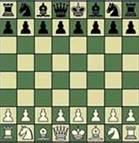
Guico Piano/Italian (C50-C54)
Italian (C50-C54) [1. e4 e5 2. Nf3 Nc5 3. Bc4 Bc5]
(Note: 4. d3 becomes "Guico Piano")
The beginning is always a good place to start. The Guico Piano is the first recorded opening according to the Gottingen manuscript (1490)
In looking at any opening, it is important to consider the strategy behind each move; why each move is being made.
White's "Italian bishop" at c4 prevents Black from advancing in the center with ...d5 and attacks the vulnerable f7-square. White plans to dominate the center with d2–d4 and to attack the Black king. Black aims to free his game by exchanging pieces and playing the pawn break ...d5, or to hold his center pawn at e5.
The Portuguese Damiano played it at the beginning of the 16th century and the Italian Greco played it at the beginning of the 17th century. The opening is also known as the Italian Game (Pinski 2005:5), although that name is also used to describe all games starting with 1.e4 e5 2.Nf3 Nc6 3.Bc4, regardless of Black's third move (Gufeld & Stetsko 1996:5). The Giuoco Piano was popular through the 19th century, but modern refinements in defensive play have led most chess masters towards openings like the Ruy Lopez that offer White greater chances for long term initiative. Anatoli Karpov used it against Viktor Korchnoi twice in the 1981 World Championship tournament, with both games ending in a draw. Garry Kasparov used it against Joël Lautier at Linares 1994, resigning after 26 moves.
It is one of the favored openings of Paul Morphy, who used it frequently.
Illustrative Games
This topic may also be tracked from my blog, here.
Feel free to comment and feel free to paste other links to other discussions of the Guico Piano, paste or link games, etc.
